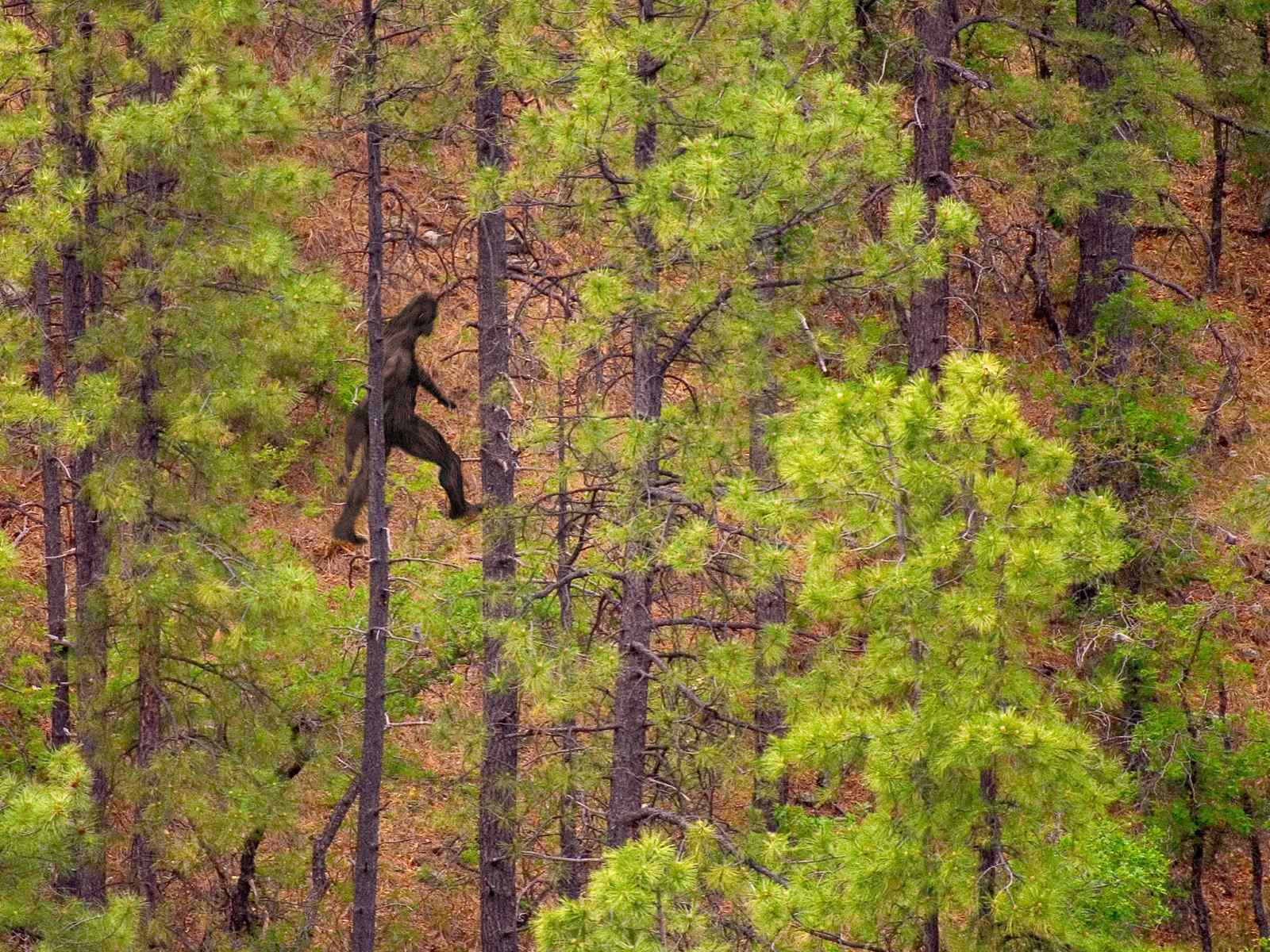
Bigfoot sightings have intrigued people for decades. From dense forests to remote mountains, tales of this elusive creature spark curiosity and debate. But what do we really know about these encounters? Bigfoot, also known as Sasquatch, is often described as a large, hairy, bipedal humanoid. Reports of sightings span across North America, with some dating back centuries. Eyewitness accounts, blurry photos, and mysterious footprints fuel the legend. Skeptics argue it's all a hoax or misidentification, while believers hold firm to their experiences. Whether you're a skeptic or a believer, these 40 facts about Bigfoot sightings will give you plenty to ponder.
Key Takeaways:
- Bigfoot, also known as Sasquatch, has been a part of North American folklore for centuries. The elusive creature is said to roam forests, leaving behind mysterious footprints and sparking countless debates. Here are some fascinating facts about Bigfoot sightings that might surprise you.
- Despite skepticism, modern sightings of Bigfoot continue to be reported. These encounters often share common elements, adding to the mystery. Scientists and researchers have taken an interest in Bigfoot, conducting various studies to uncover the truth behind the legend.
Bigfoot: The Legend Lives On
Bigfoot, also known as Sasquatch, has been a part of North American folklore for centuries. The elusive creature is said to roam forests, leaving behind mysterious footprints and sparking countless debates. Here are some fascinating facts about Bigfoot sightings that might surprise you.
-
The Patterson-Gimlin Film: In 1967, Roger Patterson and Bob Gimlin captured what is arguably the most famous footage of Bigfoot in Bluff Creek, California. The film shows a large, hairy creature walking through the forest.
-
Gigantopithecus Theory: Some scientists believe Bigfoot could be a descendant of Gigantopithecus, a giant ape that lived in Asia over 100,000 years ago.
-
Footprint Evidence: Many Bigfoot sightings include large footprints, some measuring up to 24 inches long. These prints often show dermal ridges, similar to human fingerprints.
-
Native American Legends: Indigenous tribes across North America have stories of large, hairy creatures. The name "Sasquatch" comes from the Halkomelem language of the Pacific Northwest.
-
The Skookum Cast: In 2000, researchers in Washington State found a large body impression in mud, believed to be from a reclining Bigfoot. The cast showed detailed muscle impressions.
Modern Sightings and Reports
Despite skepticism, modern sightings of Bigfoot continue to be reported. These encounters often share common elements, adding to the mystery.
-
Thermal Imaging: In recent years, thermal cameras have captured heat signatures of large, bipedal creatures in remote forests, believed to be Bigfoot.
-
Audio Recordings: Researchers have recorded strange vocalizations in the wilderness, including howls, screams, and wood knocks, thought to be communication methods of Bigfoot.
-
Hair Samples: Some sightings have resulted in the collection of hair samples. While many are identified as known animals, a few remain unidentified.
-
Eyewitness Accounts: Thousands of people claim to have seen Bigfoot, describing a tall, muscular creature covered in dark hair, with a distinct, unpleasant odor.
-
Trail Cameras: Motion-activated cameras set up in forests have captured images of large, shadowy figures, sparking debates about their authenticity.
Scientific Investigations
Scientists and researchers have taken an interest in Bigfoot, conducting various studies to uncover the truth behind the legend.
-
DNA Analysis: DNA tests on hair, blood, and tissue samples have been inconclusive, with some results pointing to unknown primates.
-
The Bigfoot Field Researchers Organization (BFRO): Founded in 1995, BFRO is dedicated to investigating and documenting Bigfoot sightings across North America.
-
Dr. Grover Krantz: An anthropologist who believed in Bigfoot's existence, Krantz studied footprint casts and argued they showed anatomical features of a real creature.
-
Dr. Jeff Meldrum: A professor of anatomy and anthropology, Meldrum has analyzed hundreds of footprint casts and supports the possibility of Bigfoot's existence.
-
The Erickson Project: A private research group that claimed to have captured high-definition video footage of Bigfoot in Kentucky.
Bigfoot in Popular Culture
Bigfoot has made a significant impact on popular culture, appearing in movies, TV shows, and even commercials.
-
"Harry and the Hendersons": This 1987 comedy film features a family that befriends a Bigfoot, bringing the creature into mainstream media.
-
Bigfoot Festivals: Towns like Willow Creek, California, and Honobia, Oklahoma, host annual Bigfoot festivals, celebrating the legend with events and activities.
-
TV Shows: Programs like "Finding Bigfoot" and "Expedition Bigfoot" follow teams of researchers as they search for evidence of the creature.
-
Commercials: Bigfoot has appeared in various commercials, often portrayed humorously, such as in ads for beef jerky.
-
Books and Comics: Numerous books and comic series feature Bigfoot, exploring different aspects of the legend and its impact on society.
Regional Sightings and Hotspots
Certain areas in North America are known for frequent Bigfoot sightings, becoming hotspots for enthusiasts and researchers.
-
Pacific Northwest: Washington, Oregon, and Northern California are prime locations for Bigfoot sightings, with dense forests providing ideal habitats.
-
Appalachian Mountains: The rugged terrain of the Appalachians has been home to many reported encounters with Bigfoot.
-
Rocky Mountains: Colorado and Montana have numerous sightings, with witnesses describing large creatures in remote mountain areas.
-
Great Lakes Region: States like Michigan and Ohio have reported sightings near large bodies of water and dense forests.
-
Florida's Skunk Ape: In the swamps of Florida, a creature known as the Skunk Ape is believed to be a regional variant of Bigfoot, characterized by its strong odor.
Skepticism and Hoaxes
Not everyone believes in Bigfoot, and some sightings have been proven to be hoaxes. Skepticism remains a significant part of the Bigfoot debate.
-
Ray Wallace Hoax: In 2002, it was revealed that Ray Wallace had created fake Bigfoot footprints in the 1950s, sparking initial interest in the creature.
-
The Georgia Bigfoot Hoax: In 2008, two men claimed to have found a Bigfoot body in Georgia, which turned out to be a rubber suit.
-
Skeptical Inquirer: This magazine often publishes articles debunking Bigfoot sightings, arguing that many can be explained by misidentifications or hoaxes.
-
Psychological Explanations: Some psychologists suggest that Bigfoot sightings could be a result of pareidolia, where people see patterns, like faces or figures, in random stimuli.
-
Lack of Physical Evidence: Critics argue that despite numerous sightings, no conclusive physical evidence, such as bones or bodies, has been found.
Bigfoot Organizations and Research Groups
Various organizations and research groups are dedicated to studying Bigfoot, each with its own methods and theories.
-
North American Wood Ape Conservancy (NAWAC): Focuses on scientific research and documentation of Bigfoot sightings in North America.
-
Sasquatch Genome Project: Claims to have sequenced Bigfoot DNA, suggesting it is a hybrid species of human and unknown primate.
-
Olympic Project: A research group in Washington State that uses trail cameras, audio recorders, and other technology to gather evidence of Bigfoot.
-
Texas Bigfoot Research Center: Conducts field investigations and public education about Bigfoot in Texas and surrounding states.
-
International Bigfoot Society: Based in Oregon, this group collects reports and conducts research on Bigfoot sightings worldwide.
Bigfoot and Technology
Advancements in technology have provided new tools for Bigfoot researchers, leading to intriguing discoveries and ongoing debates.
-
Drones: Equipped with high-resolution cameras, drones can cover large areas of wilderness, capturing potential evidence of Bigfoot.
-
Motion Sensors: Placed in remote locations, motion sensors can trigger cameras or audio recorders when detecting movement, increasing the chances of capturing Bigfoot activity.
-
Satellite Imagery: Researchers use satellite images to identify potential Bigfoot habitats and track changes in the environment that might affect sightings.
-
Social Media: Platforms like YouTube and Facebook allow witnesses to share their encounters and evidence, reaching a wider audience and sparking discussions.
-
Crowdsourcing: Online communities and apps enable people to report sightings and share information, creating a collaborative effort to uncover the truth about Bigfoot.
The Mystery Continues
Bigfoot sightings have fascinated people for decades. From the dense forests of the Pacific Northwest to the snowy peaks of the Himalayas, stories of this elusive creature persist. Some believe Bigfoot is a relic from a bygone era, while others think it's a product of overactive imaginations. Despite countless expeditions and modern technology, concrete evidence remains elusive. Yet, the allure of Bigfoot endures, drawing in new generations of enthusiasts and researchers. Whether you're a skeptic or a believer, the legend of Bigfoot continues to captivate. Maybe one day, the truth will finally be revealed. Until then, the mystery remains, fueling our curiosity and sense of adventure. Keep your eyes open; you never know what you might find in the shadows of the wilderness.
Frequently Asked Questions
Was this page helpful?
Our commitment to delivering trustworthy and engaging content is at the heart of what we do. Each fact on our site is contributed by real users like you, bringing a wealth of diverse insights and information. To ensure the highest standards of accuracy and reliability, our dedicated editors meticulously review each submission. This process guarantees that the facts we share are not only fascinating but also credible. Trust in our commitment to quality and authenticity as you explore and learn with us.


